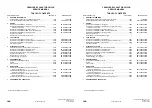
Operator’s Manual
© Copyright 2018 - Rail-Ability Limited
Page
11
of
71
Conversion
•
Contact the power company to de-energize the line.
•
If you are in the machine cabin, stay inside without touching the machine body because it's
extremely hazardous to go out before the line is de-energised.
•
Help the electrocuted person if you know the first-aid procedures, otherwise wait for the
paramedics to arrive.
•
Do not operate the machine during lightning or storms.
•
Refer to Engineering Acceptance Certificate for live OLE limitations.
•
Inspect daily for damaged cables and wires. Replace damaged items before operating.
•
Avoid contact with electrical terminals.
•
Earth bonding straps:
•
Straps must be in place at all times and securely fastened.
•
Inspect the straps daily.
•
Replace straps immediately if there are any signs of burning or damage.
•
Replace damaged straps before operating.
•
Check impedance levels after refitting any straps.
•
Earth bonding straps are fitted on the machine in the following positions:
•
Between front rail axle and chassis
•
Between machine upper structure and continuously along the boom
•
Between second stage boom and arm.
•
Avoid electrical shock from contact with battery terminals. Remove all rings, watches and other
jewellery.
•
Ensure a C Form has been obtained before on-tracking the machine in OLE areas.
6.4 Travel Hazards
•
Observe and use colour-coded direction arrows on the machine for drive functions.
•
Be aware of limited sight distance and blind spots when
driving. Use a ‘banksman’ or machine
controller when required.
•
Limit travel speed according to conditions, slope, location of personnel, and any other factors
which may cause collision.
•
If a hook protrudes outside the edge of the machine, it must be removed before travelling.
•
Take care while travelling on rail, especially when the boom is elevated.
•
Beware of slippery and limited traction conditions on rail. Braking distance can increase
significantly in wet or icy conditions.
•
The machine does not have direct view in reverse so the rear and side camera, in cab display are
provided to enhance operator visibility by reducing blind spots and should be used accordingly.
•
The machine is to proceed at walking speed and ground staff control the movement in reverse
until the superstructure can be slewed to face direction of travel.
•
The machine does not have a load area and should not be used to carry loads on any part of the
structure other than in the bucket or attachment if appropriate.
6.5 Tip-over Hazards
•
Do not alter or disable the safety switches (e.g. limit and proximity switches).






























